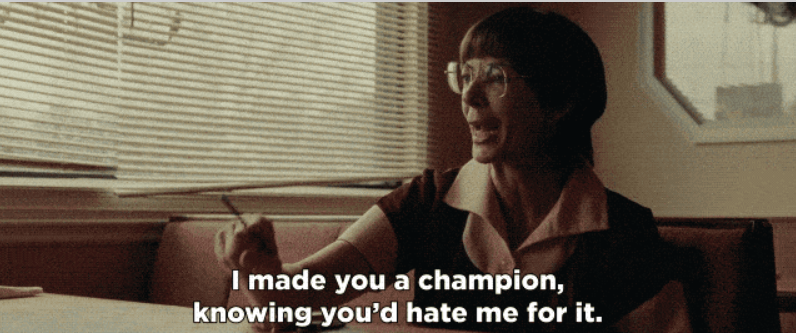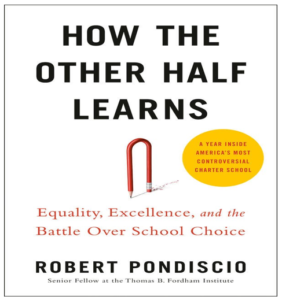
Robert Pondiscio has stirred up a hornet’s nest with his new book How the Other Half Learns about a year he spent embedded in a New York City Success Academy.
Success Academy gets phenomenal results, not just in comparison to neighboring high poverty schools, but also in comparison to New York’s leafy suburbs. Pondiscio, however, finds that a large amount of parental involvement is the “secret sauce” of the Success Academy. As Pondiscio explained in the Wall Street Journal:
 At every step, school leaders aggressively preach to prospective parents about their no-nonsense culture and the expectation that parents come with eyes wide open, fully committed to Success Academy’s program and policies, including strict behavior codes, school uniform compliance, supervising homework, reading with children every night and recording what’s read in a log. Parents are warned repeatedly in unsparing language, “Success Academy may not be for you.” Significantly, the schools offer no transportation or after-school programs, a potential deal breaker for working single parents or those without the support network to pick up and drop off their children every day.
At every step, school leaders aggressively preach to prospective parents about their no-nonsense culture and the expectation that parents come with eyes wide open, fully committed to Success Academy’s program and policies, including strict behavior codes, school uniform compliance, supervising homework, reading with children every night and recording what’s read in a log. Parents are warned repeatedly in unsparing language, “Success Academy may not be for you.” Significantly, the schools offer no transportation or after-school programs, a potential deal breaker for working single parents or those without the support network to pick up and drop off their children every day.
This process, whether by happenstance or design, yields a parent body comprised largely of the most motivated parents and those with the organizational skills and resources to meet Success Academy’s high bar for parental engagement. This sets the stage to strive for—and mostly achieve—consistent and high levels of academic achievement “at scale” among low-income children of color, who would otherwise be lost to the dull hum of mediocrity in zoned neighborhood schools.
Predictably, the many critics of Success Academy pounced at the notion that Success Academy had “cherry picked” their students, but Pondiscio’s point on this matter is more nuanced and profound: Success Academy has created and sustained a culture of sky-high expectations that can and does work wonders for those willing to buy-in.
This is self-selection rather than cherry picking, and it is so common in the district school system as to seem unremarkable to the point of going unnoticed. Folks who live in fancy suburbs: self-selected. Folks who take the New York test given for admission to specialized district schools? Cherry picked.
Success Academy families are self-selected. Pondiscio notes that while upper middle-class parents self-select routinely into high-achieving schools, Success Academy creates a similar opportunity for low-income families of color.
Success Academy’s tough approach also draws no shortage of critics, but Pondiscio makes clear in a Fordham Institute piece that the SA approach is tough love:
It is nearly inconceivable that a school could create or sustain this kind of school culture—or any well-articulated and coherent culture—in the absence of parents making a clear-eyed decision to sign up for it and vote with their feet. If school culture and parental buy-in is what differentiates successful schools from less successful schools, if we prevent low-income black and brown parents, and only those parents, from self-selecting into productive school cultures that fit their desired “social category and ideal,” we are functionally imposing mediocrity on those families—and only those families. If we want to start unwinding and correcting the chronic and persistent underperformance of schools serving low-SES Americans, let’s start there.
In other words, cancel that order of Tonya Harding’s mom analogies, K-12 traditionalists. Unlike poor Tonya suffering under a cruel mother as a child, this association is entirely voluntary. Success Academy is crushing the academic ball among low-income families of color who really want this sort of education. It is an unambiguously good thing that those families have this opportunity. We should celebrate anytime any family finds a good fit school for their children. They paid their taxes after all; if they are happy, then so am I.
I preordered my copy of How the Other Half Learns and I look forward to reading it in full. Success Academy is neither the cause nor the cure for the world’s pain, but it is a vitally important opportunity for some families in New York City communities that are traditionally very poorly served by a system of zip code assignment to largely undifferentiated schools. These families deserve these and many more opportunities.



Matthew
you’ll enjoy the book despite Robert saying that everyone will hate it.
Next time you’re in Gotham I hope we can discuss this face-to-face but in one chapter he delves into the challenges they face in HS. If the state tests are the acme of academic competence in k-8, the HS experience – not unique to SA of course – raises the question of the end for which we are preparing these students. Are the tests flawed? Is HS asking for such diametrically different effort and outcome that k-8 is flawed?
I write this comment from college common center on a visit with my child, hearing all the usual comments about readiness, independence, competence, etc. And the prospective students I see do not appear to come from anything like the backgrounds SA serves.
Complicated questions all around us.
Nothing scare the Democrat/Education Union cartel more than the Success Academy.
[…] Matthew Ladner wrote in an unrelated piece about New York charter schools yesterday, “We should celebrate anytime any family finds a […]
[…] Matthew Ladner wrote in an unrelated piece about New York charter schools yesterday, “We should celebrate anytime any family finds a […]
[…] Matthew Ladner wrote in an unrelated piece about New York charter schools yesterday, “We should celebrate anytime any family finds a good […]
[…] Matthew Ladner wrote in an unrelated piece about New York charter schools yesterday, “We should celebrate anytime any family finds a […]